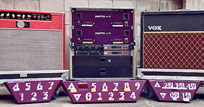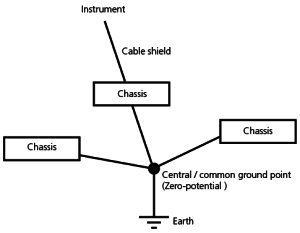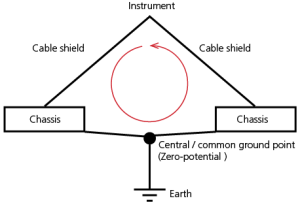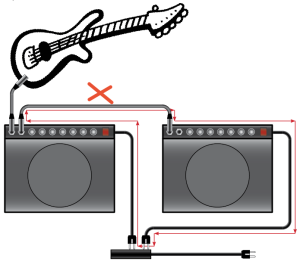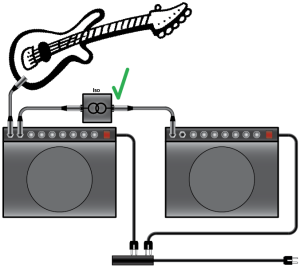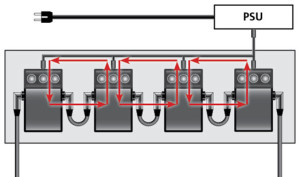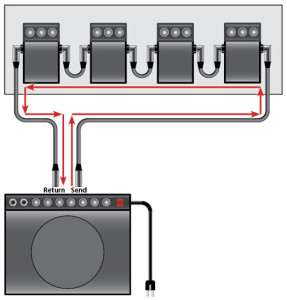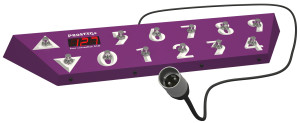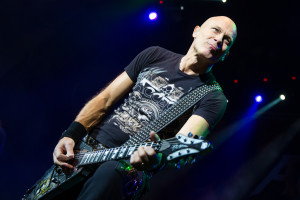Humfree guitar rig wiring is not easy. Hum can have many different causes. This article gives you the basic skills for properly wiring a guitar rig and will save you some headaches in your rig building adventure. For more detailed instructions, please download “The ultimate Guitar Rig Building Guide“.
Hum Caused by Ground Loops
Ground loops are certainly the most common reasons responsible for the hum. These are caused by double grounding connections. Thus, they have something to do with earth and cable shield. To understand and to get rid of ground loops, it is important to distinguish between “earth”, “chassis” and “cable shield”. But in a way, “earth”, “chassis” and “cable shield” are the same, because they are somehow connected. And the term “Somehow” is exactly the problem. To avoid ground loops, we need to know where “earth”, “chassis” and “cable shield” are connected. When wiring a guitar rig, we must be aware where we want them to merge.
Earth: (also called “ground”): The earth is, as the name suggests, the connection to the earth. This is the zero potential. In power cables, the connection to earth is called “grounding conductor”.
Chassis: If the chassis (housing) of a device is made of metal and the device is operated with mains voltage (120 / 240V), the housing must be grounded for safety reasons (the chassis is thus connected to earth within the device).
Cable Shield: The shield is used to keep electromagnetic fields from the audio signal. Within guitar cables, this is the outer, mostly braided conductor. In order that the cable shield can fulfill its function, it must be connected to earth.
Conclusion: Earth, Chassis and Cable Shield are always connected somewhere. To prevent hum by ground loops, it is important to know where they are connected.
Star-shaped Wiring
Basically, the connection of “Earth”, “Chassis” and “Cable Shield” must be structured like a star:
Triangle | Ring Wiring
If the star-shaped structure is not strictly observed and instead wiring is made in a triangle, the classic Ground Loop occurs. The problem is that the instrument is connected via two different paths to earth and the current can, therefore, flow through two different ways, respectively, the current can flow in a circle.
Groundloop Caused by Split Guitar Signal
A typical example of such a triangle wiring is the use of two amplifiers. The following diagram shows a typical ground loop:
In a guitar amp, the earth from the power cable and the shield of the guitar cable are connected both to the chassis. Thus, in our example, the guitar is grounded once through the amplifier on the left and once through the amplifier on the right. It does not matter whether the guitar signal is split by a Y-cable, or if the second amplifier is connected to the first amplifier.
Due to the cable resistances, the potential for the two amplifiers are quite minimally different (we are talking about millivolts). Therefore, along the line marked in red, a small current begins to flow in the circle. This is the Ground Loop!
This is audible as hum because this current flows with the mains frequency (50Hz in Europe, 60Hz in America). In addition, the harmonics (100 Hz, 200 Hz, …. respectively 120 Hz, 240 Hz, …. ) are also generated. The longer the cables are, the bigger is the potential difference. As a result, the hum increases with the length of the cables.
Isolating Transformers to Prevent Ground Loops
In order to prevent ground loops, the connection of the guitar cable from one to the other amplifier must be separated using an isolating transformer. Inside an isolating transformer, there is no electric connection between input and output. The signal is transmitted magnetically instead. Transformers specifically made for guitars must be used (e.g. Lehle P-Split) so that the guitar signal is transmitted unaltered. Isolating transformers for studio applications are not suited for guitars.
Groundloop over Daisy-Chain Power Supply
Another typical example of groundloops is powering the effects via daisy-chain cables or using a power supply with several outputs without galvanic isolation. Since the cables are usually very short, this hum is often inaudible.
Groundloop via Send-Return
Inserting effects in the Send/Return is also a groundloop. The longer the cables, the louder the hum. In order to avoid this hum, two approaches are possible:
- Use an isolating transformer in either the send or the return line.
- Do not use the 4-cable method to the pedalboard. Instead, connect the effects directly next to the amp with very short cables. If they must be switchable, use a MIDI controllable looper. The short cables also have the advantage to avoid dynamic and transparency losses.
More Information …
This was just a brief introduction to the main issue of hum. But hum can also be introduced by many other things, e.g. by interferences caused by lighting systems, computer monitors, fluorescent lights, nearby high-voltage lines and many other sources.
If you like to read all you need to know for successfully wiring a guitar rig, including a step-by-step instruction for trouble shooting, you can download “The ultimate Guitar Rig Building Guide” which explains everything in detail on over 30 pages.

